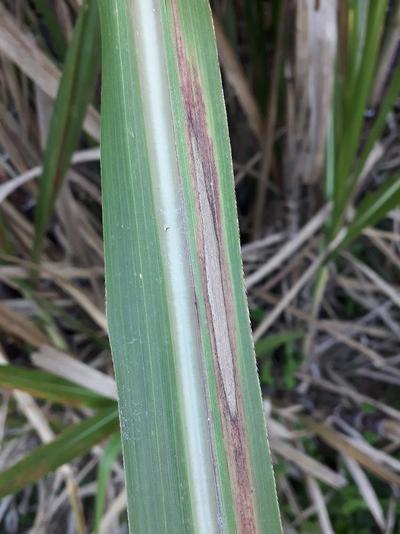Leaf Scorch of Sugarcane
Stagonospora sacchari
Fungus
In a Nutshell
- Leaves show abnormal minute darkish red spots with a yellowish halo.
Can also be found in
Symptoms
Initial symptoms are small with white to yellowish spots on the leaf blades, and they usually occur between 3 and 8 days after inoculation. Red or reddish-brown spots appear on young leaves and gradually elongate to become spindle-shaped with a clear yellow ring. In case of disease severity, spots coalesce and extend along the vascular bundles to leaf apex and form spindle-shaped streaks. Lesions are reddish-brown at first which later turns to straw-coloured, bordered by red margins. Small black pycnidia are also produced in the dead leaf tissue. Severely infected leaves dry and fall off prematurely. The infection reduces stalk height, diameter and the number of internodes, as well as the number of green leaves.
Recommendations

Organic Control
To this day, we are not aware of any biological control method available against this disease. If you know of any successful method to reduce the incidence or gravity of the symptoms, please contact us.

Chemical Control
Always consider an integrated approach with preventive measures together with biological treatments, if available. Apply fungicides such as Carbendazim and Mancozeb. Spray Bordeaux mixture or Chlorthalonil, Thiophanate-methyl, and Zineb.
What caused it?
The symptoms are caused by the fungal pathogen of Stagonospora sacchari, which causes severe blighting and greatly reduces the photosynthetic activity of the plants. The disease occurs mainly after rains or when excess irrigation is given to fields. This results in the reduction of the functional leaf area. The disease cannot be transmitted through soil, seed cane and farming tools. It is mainly transmitted through airflow, wind, and rain. In dry weather, streak formation is rapid. Most streaks coalesce, elongate, block maturation and change the tissue colour. Streak formation is more obvious during spring and autumn, and while in winter, temperatures are usually too low for the pathogen to survive. Finally, the whole surface of the leaf shows a typical scorched appearance.
Preventive Measures
- Sanitary measures help to reduce inoculum levels.
- Plant resistant varieties.
- Remove alternative hosts such as Saccharum spontaneum, Imperata cylindrica, and Rottboellia cochinchinensis.
- Remove infected leaves.
- Planting should be done when rainfall and humidity are low to reduce disease incidence.
- After harvest, severely infected fields can be burned to kill pycniospores inside pycnidia on plant debris and in the soil.
- Apply more organic, phosphorus and potash fertilizers.



